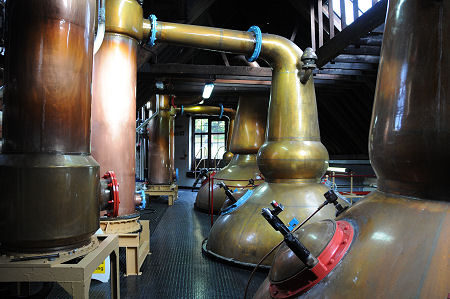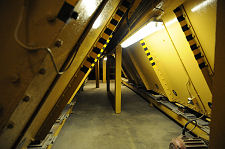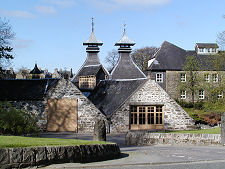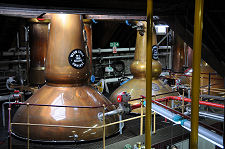 Strathisla Distillery |
Strathisla Distillery stands on the east bank of the River Isla not far north of the centre of the market town of Keith. Brown tourist signs point the way, and if you follow them you end up in a pleasantly landscaped car park on the opposite side of the B9116 from the distillery itself. Close by is the Fons Bulliens Well, the water source traditionally used by the distillery.
Strathisla is the oldest continuously operating Highland distillery, and we discuss its long history below. It is also, without a shadow of doubt, the prettiest distillery in Scotland. The setting and landscape, the shape of the stone buildings including the triangular section of the still house, the imposing pagodas, and the water wheel all combine to produce an effect that is quite enchanting. If they did distilleries in fairy stories, then they'd have to model them on Strathisla.
You begin your visit in the reception area of the visitor centre, reached via a courtyard between the arms of the building closest to the road. This was clearly once the distillery office, and from here you can progress through to a number of other rooms set out to allow you to make the most of your visit. These include the stylish and tastefully stocked shop, and a very attractive room set out as a Victorian study complete with large leather sofas.
If you didn't already know, the shop is the place that brings home most clearly the fact that Strathisla is in one respect a little unusual among distilleries with visitor centres. Bottlings of Strathisla as a 12 year old single malt whisky are available, but the distillery is best known as the home of Chivas Regal, "the world's most prestigious premium blended Scotch". Too many of us are becoming snobs who view blended whiskies as necessarily inferior products. Strathisla is as good a place as any to discover that some blends can give the drinker an experience every bit as refined as they could expect from a single malt. Different, yes, but not second best.
The distillery tour is like stepping back in time. Especially striking is the millman's office, a wooden enclave set within a corner of one floor of the building. The mill itself is a standard issue red Porteus. You almost stumble across the mash tun, set within a space that feels just a little too small for it. The almost flat copper top is, unusually, raised from the stainless steel body, with the gap between them filled in by a mesh grill that extends all way around the vessel.
There are two tun rooms, each with a collection of washbacks in what initially appears to be a random scatter across the room. There are ten washbacks in total and all are made from Oregon pine. Most show signs of considerable age, though at the time of our visit some were fairly recent replacements in wood that had yet to acquire the dark patina of age and use. You can find out more about Making Malt Whisky from our series of feature pages showing the stages in the process.
The highlight of any distillery tour has to be the still house, and this is especially true at Strathisla. The stills are housed in one of the triangular section buildings shown in the header image, and the way they are almost enclosed by the eaves of the roof space adds a huge amount of character to equipment which already has a certain mystique. You enter the still house from the rear, on a walkway that at first gives only glimpses of the stills themselves. From here you can look down on the spirit safe and, having descended to examine it, you then need to climb again to reach the level of the floor surrounding the stills. There are four of these and their "fit" within the building is so tight that any major work requires the removal of part of the roof.
The layout of the distillery and the confined nature of some of the spaces mean that Strathisla may not be the ideal place in which to try to understand the distilling process for the first time, but this is amply made up for by the sheer charm and character of the place. Visit too many distilleries and they can be a little difficult to distinguish from one another in the memory. Strathisla is unforgettable and you are unlikely ever to confuse it with anywhere else.
Cask filling takes place at the neighbouring Glen Keith distillery. The bonded warehouses at Strathisla are as fascinating as the rest of the distillery. What is particularly interesting is the slope at the end of the warehouse, complete with wooden "rails" on which casks of whisky would be rolled up for storage on the upper floor or, considerably more quickly and easily (and, presumably, dangerously), back down again when the time came to bottle. One end of the warehouse we were shown is home to the "Royal Salute Vault", named after Chivas's super-premium blended whisky aged at 21 years. This is home to some rather special casks, including a Glenlivet signed by Prince Charles.
Milltown Distillery, as Strathisla was known for much of its life, was established in 1786 by George Taylor and Alexander Milne. Some accounts suggest that the distillery was extensively rebuilt and its name was changed to Strathisla following major fires in 1876 and in 1879. There's a problem with this version of history. The distillery was visited by the author Alfred Barnard when he was researching his definitive book on distilleries between 1885 and 1887. He knew it as "Milton Distillery", but notes that the whisky it produced was marketed as "Strathisla Whisky". As far as the buildings were concerned, Alfred Barnard says that "all the Distillery buildings have an old-world look, suggestively characteristic of the long established character of the works..."
Combine this description with the two page engraving in his book showing the whole of the distillery, which includes a number of buildings easily recognisable today and it seems reasonable to believe that parts of today's distillery date back to the very early years after it was first established. Meanwhile, a large crest dated 1695 on the gable end of the shop (previously part of the maltings) facing the road suggests that at least one of the buildings might have been in use even before the distillery commenced operations.
In 1949 the distillery's then owners were declared bankrupt because of unpaid tax bills. The following year Milton Distillery was acquired at auction by Chivas Brothers Ltd. They changed the name to Strathisla Distillery to reflect the identity of the whisky it produced, and in 1961 they doubled the number of stills from two to four. In 2001 Chivas Brothers became part of Pernod Ricard.
 Inside the Still Room |

|
|
|
Visitor InformationView Location on MapSeafield Avenue, Keith, AB55 5BS. Tel: 01542 783044. strathisla.admin @pernod-ricard.com Grid Ref: NJ 430 512 Strathisla Distilery Opening Hours Tours & Admission What3Words Location: ///rant.laser.hosts |
 Crest Dated 1695 |
 Within the Distillery |
 Gift Shop Gift Shop |
 Visitor Lounge Visitor Lounge |
 Malt Bins Malt Bins |
 Porteus Mill Porteus Mill |
 The Mash Tun The Mash Tun |








